Teams - Chat
Chat is at the center of everything you do in Microsoft Teams. From individual chats with just one other person, to group chats and conversations in channels—chat has you covered.
1. Chats can be one-on-one or in a group
Sometimes, you’ll want to talk one-on-one with someone. Other times, you’ll want to have a small group chat. In Chat, you can do either.
You start one-on-one and group chats the same way: by selecting New chat in Teams. at the top of your chat list. Once in a chat, you’ll be able to send messages that include files, links, emoji, stickers, and GIFs—whatever you need to get your point across.
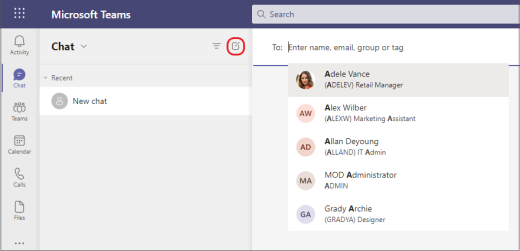
One-on-one chat
Once you’ve selected New chat Chat icon in Teams. and entered the person’s name, compose your message in the text box and then select Send Send a message icon. or press Enter. This starts the chat.

Chat with yourself
For times when you want to draft messages, send files from one device to another, or get to know features a little better, you can start a chat with yourself. Everything you do in a regular chat you can also do in a chat with yourself. You’ll see it pinned to the top of your chat list by default.
If you unpin the chat with yourself and want to find it again, select New chat Chat icon in Teams. and enter your name into the To field.

Group chat
Use a group chat when you need to talk to a small group of people. Start one the same way you start a one-on-one chat: select New chat New chat button in Teams at the top of your chat list. Select the down arrow to the far right of the To field and type a name for the chat in the Group name field. Next, type the names of the people you’d like to add in the To field.

Once the chat has begun (whether group or one-on-one), just choose it in the chat list to resume the conversation and send more messages.

2. Press Shift+Enter to start a new line
If you keep pressing Enter to start a new line, which sends the message before you’re ready, try the following:
When you want to start a new paragraph, press Shift+Enter to insert the line break. If you’ve opened your formatting options (see step 3 for details), just press Enter to start a new line of text, then select Send Send a message icon. to send it.

3. Select Format to see all your formatting options
There are many formatting options for messages.
To open your formatting options, select Format Format button in Teams beneath the box where you type your message. In this expanded view, select the text that you want to format, then choose an option like B, I, or U to bold, italicize, or underline the text. There are also options for highlighting, font size, font color, lists, and more.

Beneath the box you'll also find delivery options, attach files, emoji, giphy, stickers, schedule a meeting, and more. Select More options Format icon in Teams. to find more apps.
4. There are several ways to search for and find messages
Find a chat based on a person’s name
Enter the person’s name in the command box at the top of Teams. You’ll see their name and any group chats they're a part of with you listed. Select their name to go to your one-on-one chat with them or select a group chat to resume that one.

Find a message that has a keyword that you remember
Start typing a keyword into the command box at the top of Teams and press Enter. You’ll see a list of results that include the keyword.
Filter to show certain types of messages
From the Activity feed, select Filter Teams filter icon and then More options Microsoft Teams more options icon to show certain types of messages including unread messages, @mentions, replies, and reactions.
For a more specific search, go to the Feed menu, select the drop-down arrow, and then choose My Activity.

Find your saved messages
To save a message, hover over it, select More options Microsoft Teams more options icon, and then select Save message Save message icon in Teams.

To see a list of your saved messages, select your profile picture at the top of Teams, then choose Saved. Or, type /saved in the command box at the top of Teams.
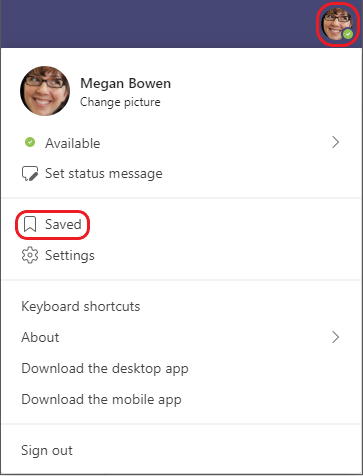
5. Hide or mute chats to keep them out of your way
While you can't delete an entire chat conversation in Teams, you can hide the chat from the chat list, or mute it so you stop getting notifications. For details, see Hide, mute, or pin a chat in Teams.
Note that you are able to delete individual messages you've sent.
When you go to any channel in Teams, the first tab you'll see is Posts. Think of Posts as one big group conversation.
Everyone who has access to the channel can see the messages on the Posts tab.

Another key thing to know about messages in a channel is that replies to a channel message stay attached to the original message. This way, the whole thread of the conversation can be easily followed by anyone reading it. This is what's great about reading threaded conversations.
-
To reply to a channel message, select the little Reply link underneath the message.
-
To post a new conversation in the channel, select the New conversation button at the lower left on the Posts tab.
Note: The New conversation button may be inactive (grayed out) depending on channel settings. In this case, only channel moderators may create new conversations.
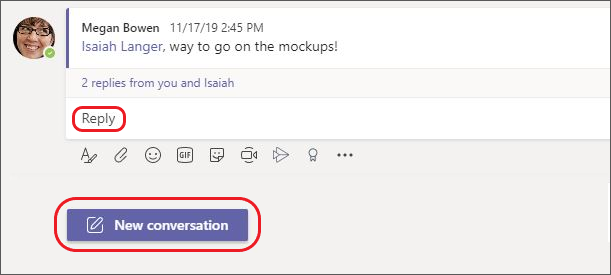
Replying to an existing message thread or starting a new conversation opens a compose box for you to type and format your message. Either option sends a message to everyone in a particular channel (the entire team).

When you're done composing your message, select Send  . Your message is now live in the channel.
. Your message is now live in the channel.
While you can't delete an entire chat in Teams, you can hide or mute it from your chat list to stop receiving notifications. You can also pin frequent conversations to the top of your chat list for quick access.
Note: You can delete individual messages that you've sent.
Hide a chat
-
Select Chat  to open the chat list.
to open the chat list.
-
Next to the conversation you want to hide, select More options  > Hide.
> Hide.
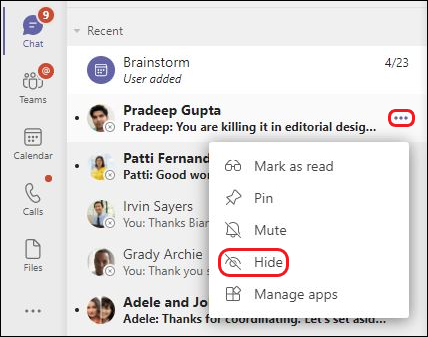
-
The chat and chat history will be hidden until someone posts a new message to it, and you can always resume an old conversation that you've hidden as well.
Unhide a chat
Need to see a hidden chat again? Unhide a chat that you've hidden before by using search.
-
In the Command box  at the top of Teams, search for the name of the person you were chatting with and select them. You'll see that the chat history is hidden (which you can choose to show by selecting it).
at the top of Teams, search for the name of the person you were chatting with and select them. You'll see that the chat history is hidden (which you can choose to show by selecting it).
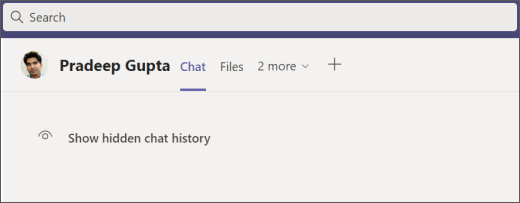
-
The conversation will now show in your chat list on the left, but if you don't see it right away you can select Filter  to search for it.
to search for it.
-
Once you've located the conversation in the chat list, select More options  > Unhide.
> Unhide.
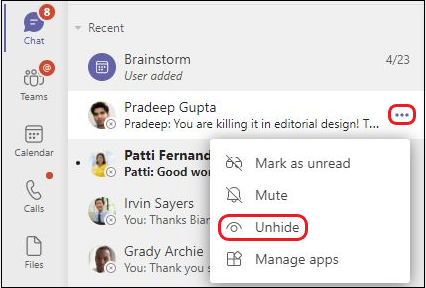
-
Select Show hidden chat history to see the conversation.
Mute a chat
When you mute a chat, you'll still be included in the conversation, but won't get notifications from it.
-
Select Chat  to open the chat list.
to open the chat list.
-
Next to the conversation you want to mute, select More options  > Mute.
> Mute.
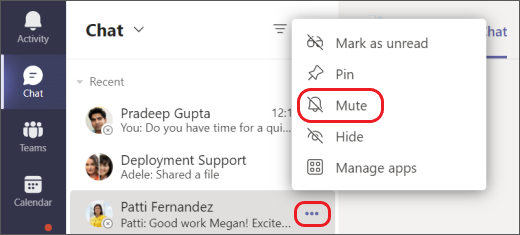
-
If you change your mind, just select it again and unmute it.
Note: An icon appears next to the names of the participants to remind you that the chat has been muted.
Pin a chat
For quick access, you can pin frequent conversations to the top of your chat list.
-
Select Chat  to open the chat list.
to open the chat list.
-
Next to the conversation you want to pin, select More options  > Pin. This ensures that the chat stays at the top of your list.
> Pin. This ensures that the chat stays at the top of your list.

-
If you change your mind, just select it again and unpin it.
It's simple and quick to pop out your one-on-one or group chat into a separate window. Then, resize, reposition, or close the window if you want to. It’s a good way to get more done when you’re in a meeting or in a call. (Note that you can pop out multiple conversations, but not the same chat twice.)
Tip: To do other things (like scheduling meetings, attaching a OneDrive File, adding apps), return to the main app to find those familiar features. You don't need to close the pop-out chat window.
Note: The Pop-out chat feature is currently available in the desktop app for Windows and Mac only. It's not yet supported for Teams on the web, Linux, or mobile.
There are a few options to pop out a chat in Teams. Here are a few different methods:
From the chat list
-
On the left side of Teams, select Chat  to open the chat list.
to open the chat list.
-
Find the chat you want.
-
Select More options  > Pop-out chat
> Pop-out chat  . Or, double-click the chat name and you’ll see a new pop-out chat window.
. Or, double-click the chat name and you’ll see a new pop-out chat window.
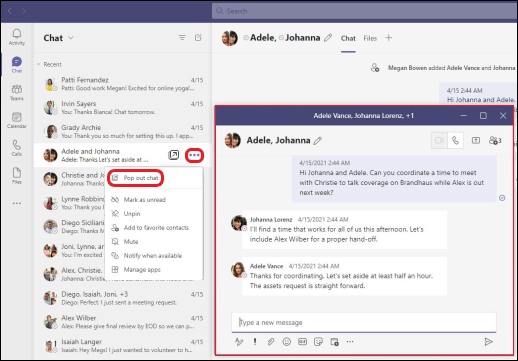
By hovering over a chat
When you hover over a chat, you'll see the pop-out chat icon  . Select it to open a new pop-out chat window.
. Select it to open a new pop-out chat window.
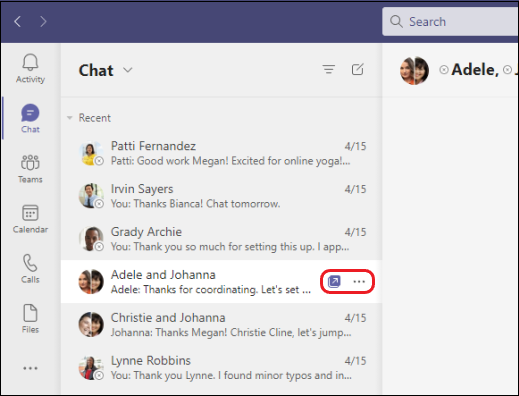
From the chat itself
Go to the upper-right corner of the chat and select Pop-out chat  .
.
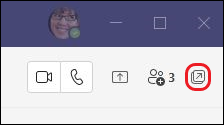
From a profile picture
Double-click the profile picture of the person you want to have a conversation with to pop out a new window.
From the command box
In the command box at the top of Teams, type /pop. Choose the chat you want to pop out.
When you're chatting with one or more people in Teams, you can instantly share your screen. Go to the chat controls in the upper-right corner and select Share  .
.
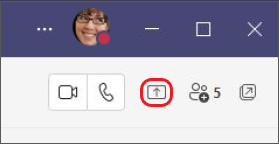
Choose a window to share that specific program and its content, or select Desktop to share everything on your screen.
The other participants in the chat will receive a notification asking them to accept your screen share. Once they do, they'll be able to see your screen and continue the chat.
When you're done sharing, go to your meeting controls and select Stop sharing.
Note: Linux users can't share screens in a Teams chat at this time.
It’s easy to reply to a specific message in your chat. This way, people will have helpful context when they read your reply. In chats, there can be many replies back and forth. When you reply to a specific message, you add clarity to your one-on-one, group, and meeting chats.
-
On the left side of Teams, select Chat  to open the chat list.
to open the chat list.
-
Find the chat you want, and then go to the message you want to reply to.
-
Hover over the message, and choose More options  > Reply.
> Reply.

4. The message you selected will appear in the compose box. Type your reply in the compose box, and select Send  .
.

Reply to multiple messages at once
-
Hover over a message, and choose More options  > Reply.
> Reply.

2. Repeat step one for each message you want to reply to.
3. The messages you selected will appear in the compose box. Type your reply in the compose box, and select Send  .
.
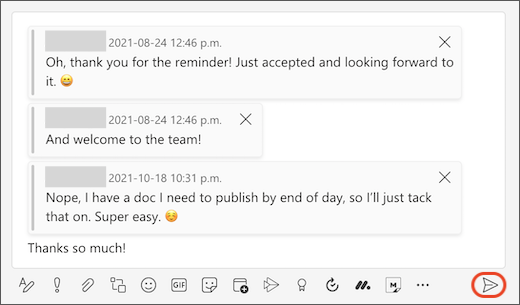
How to find the original message
When you see a reply to a specific message in Chat, it’s simple to find the original message. Select the message preview in the compose box or in the chat, and Teams will scroll up to the location of that particular message.

Note: If the original message is more than 30 days old, you’ll need to scroll through your chat history to find it.
There are several formatting options for messages.
To open your formatting options, select Format  beneath the compose box. In this expanded view, select the text you want to format, then choose an option such as B, I, or U to bold, italicize, or underline the text.
beneath the compose box. In this expanded view, select the text you want to format, then choose an option such as B, I, or U to bold, italicize, or underline the text.

There are also options for highlighting, font size, lists, and more. See More options  for additional formatting options and the buttons below the box for attaching a file or inserting fun stuff like emoji.
for additional formatting options and the buttons below the box for attaching a file or inserting fun stuff like emoji.
Note: Teams underlines spelling errors in red as you type. Right-click the error to see a list of suggested corrections. Currently, you can't run a separate spelling and grammar check in Teams (unless you're working in your Wiki tab).
Mistakes happen. Fortunately, you can edit or delete the messages sent in Teams.
Edit a sent message
You can edit any message that you have sent to a chat or channel.
-
Go to the message and select More options  > Edit.
> Edit.
-
Make changes to your message, then press Enter to save the update.

There's no limit to how many times you can make changes to a sent message.
Delete a sent message
If you need to backtrack and delete something you just sent, go to the message and select More options  > Delete.
> Delete.
If you haven't sent the message yet, select Format  to expand the box and then select Delete
to expand the box and then select Delete  .
.

Undo a deleted message
Go to the deleted message and select Undo.
Keep your chat list organized and focused by deleting entire chat threads in Teams. One-one-one chats, group chats, and meeting chats can all be deleted from your chat list.
-
From Chat on the left side of Teams, go to the chat you want to delete and select More options  > Delete Chat.
> Delete Chat.
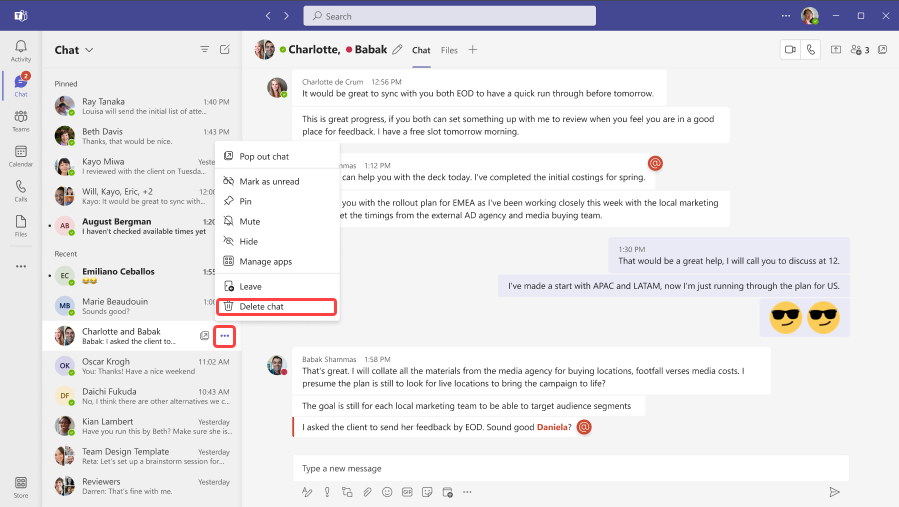
-
Select Delete.
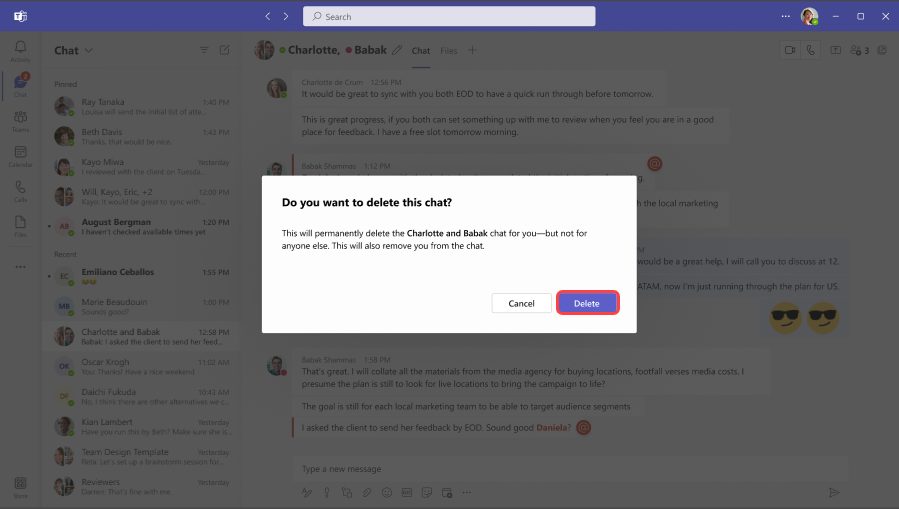
Once you've selected Delete, the chat will be permanently removed from your chat list and conversation history will be deleted. When this happens, you won't be able to search for messages that were part of the deleted chat thread.
Note: If you are a meeting owner, you cannot delete the meeting chat. However, if you are a participant in the meeting chat, you can delete it.
If you want to save a message to read later, it's simple to mark it as saved or unread.
Go to the top of the message and then select More Options  > Save this message or Mark as unread.
> Save this message or Mark as unread.
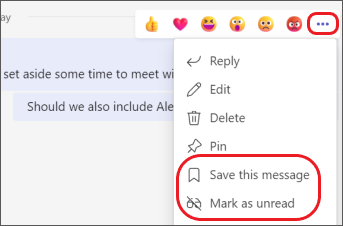
To see a list of your saved messages, select your profile picture at the upper-right corner of Teams, then choose Saved.
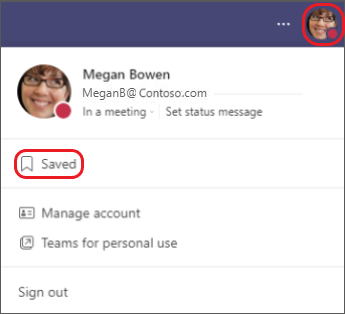
To help make sure your message gets noticed, mark it as important or urgent.
To do this, select Set Delivery Options  beneath the compose box, and then select Important or Urgent.
beneath the compose box, and then select Important or Urgent.
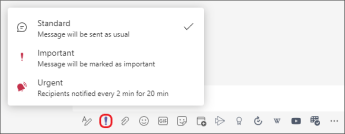
This adds the word IMPORTANT! or URGENT! to your message. Once in the message, you can include files, links, or pictures—whatever is needed to get your point across.

To undo this option, select Standard from your delivery options, and the message will be sent as usual.
An urgent message notifies a person or group repeatedly, every 2 minutes for 20 minutes, or until they read it. You’ll need to decide what messages are urgent based on your organization or group.
Note: If you don't see the option to mark a message as important or urgent, it may be because there are more than 20 members in your group chat. If there are more than 20 members in your group chat, the option to mark a message as important or urgent is located in the format options. Also, your admin must enable important or urgent messages. Important or urgent message options aren’t available when you start a chat with yourself.
Sometimes you might want to pin a particular chat message for reference in a one-to-one or a group chat. A pinned message appears at the top of the chat and remains there until removed or replaced.
Things to know about pinned chat messages:
-
When someone pins a message in a chat, everyone in that chat can see it.
-
Only one message can be pinned at a time.
-
A pinned message doesn’t affect an ongoing chat.
-
Anyone in a chat, except guests, can unpin any pinned message or replace it with a different message.
-
If someone selects a pinned message, they'll go to the original message in the chat.
Pin a chat message
-
In a chat conversation, hover over the specific message that you want to pin.
-
In the menu that appears above the message, select More options  .
.

-
In the More options menu, choose Pin  . The pinned message appears at the top of the chat. It also includes the name of the author and the date or time it was originally posted.
. The pinned message appears at the top of the chat. It also includes the name of the author and the date or time it was originally posted.
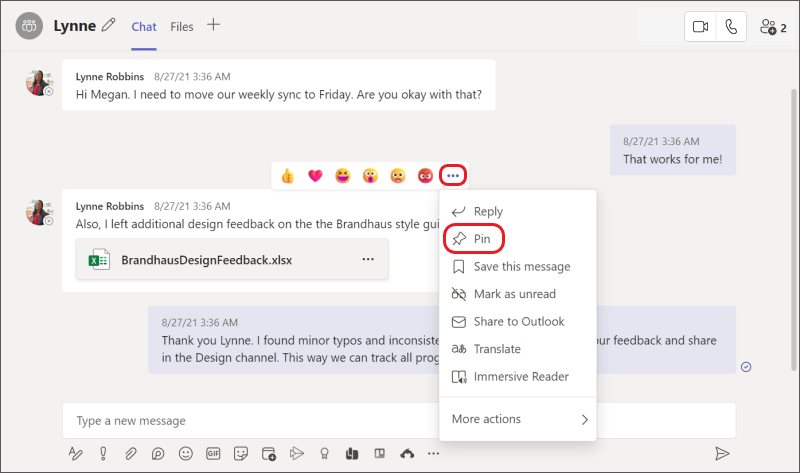
Note: A pinned chat message may be any length. However, only a single line of text that fits within the width of the chat window will be visible.
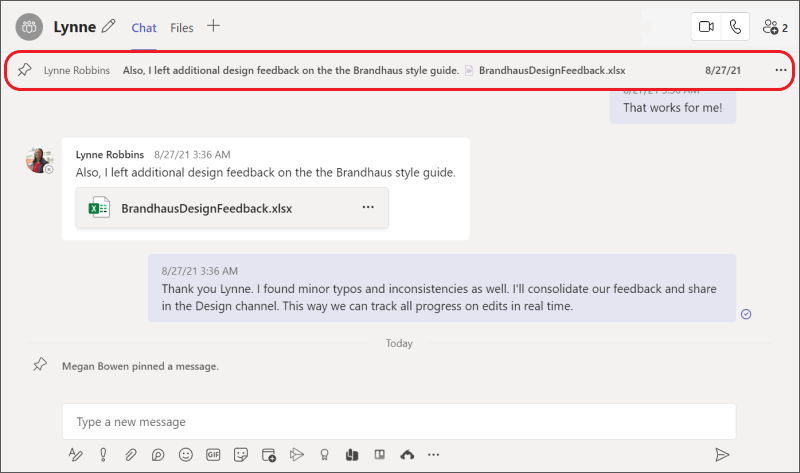
Pinned chat message at the top of a chat
Unpin a pinned chat message
-
Go to the pinned message at top of the chat.
-
Select More options  > Unpin
> Unpin  .
.

-
In the confirmation, select OK.

Replace a pinned chat message
To replace a pinned chat message with a new one, just pin a new message. You’ll get a confirmation asking if you want to replace the original pinned message.

Depending on your monitor size and viewing preference, you might want to change the amount of spacing that appears in chat messages. Whether you want to optimize to see more text at once or read less text at a more comfortable level, Teams lets you customize the chat density to suit your needs.
Show more text in compact mode
By default, chat density is set to comfy mode, but if you'd like to see more text you can change this in your settings.
-
From the upper-right area of your screen, select Settings and more  > Settings > General.
> Settings > General.
-
Under Chat density, select Compact.
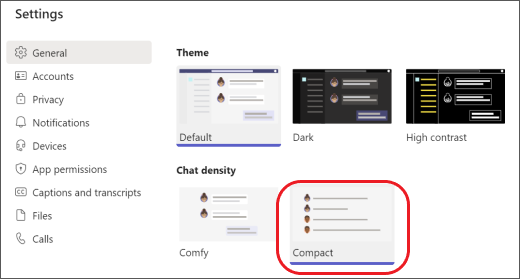
You'll now see more of the chat and a wider box where you type messages.
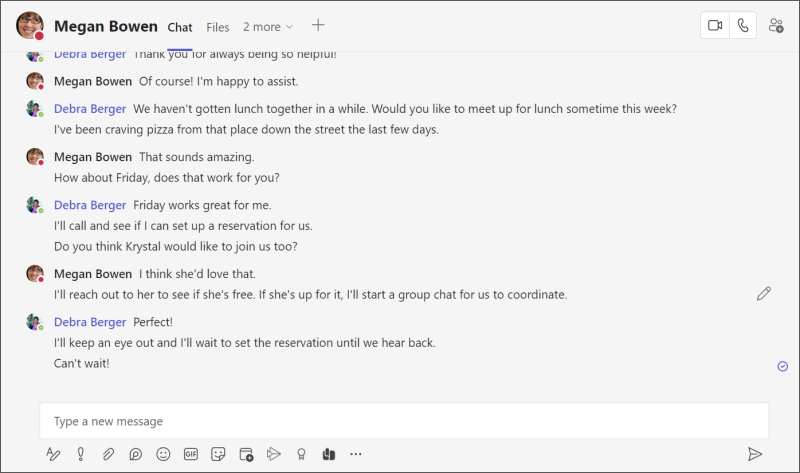
Show more space in comfy mode
If you'd like to switch back to comfy mode, simply follow the steps below:
-
From the upper-right area of your screen, select Settings and more  > Settings > General.
> Settings > General.
-
Under Chat density, select Comfy.
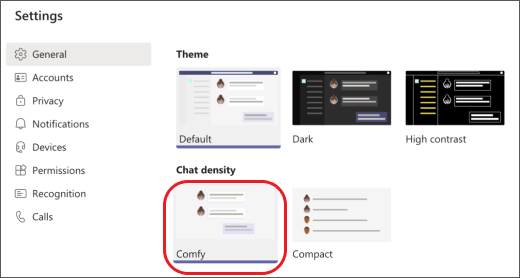
You'll now see more space in and between your messages.
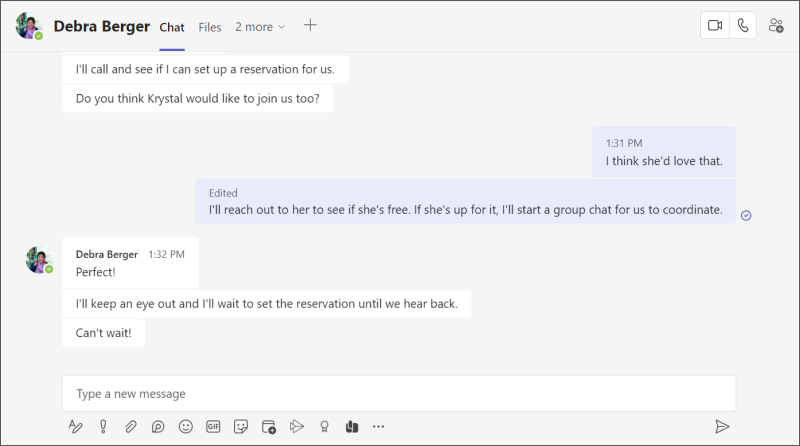
Emoji, animated GIFs, and stickers are a great way to add some fun and express yourself in your communications! Plus, we've added new emoji galleries with over 1800 emoji to choose from, including some you can personalize.
Send an emoji
To insert an emoji in a chat or channel message:
-
Select Emoji  beneath the message box.
beneath the message box.
-
At the bottom of the pop-up window, choose one of the new emoji galleries. The starting gallery is Smilies, but there are also Hand gestures, People, Animals, Food, Travel and places, Objects, Activities, and Symbols.
-
Select the emoji that you want from your chosen emoji gallery.
-
Once you've inserted the emoji you want, select Send  .
.
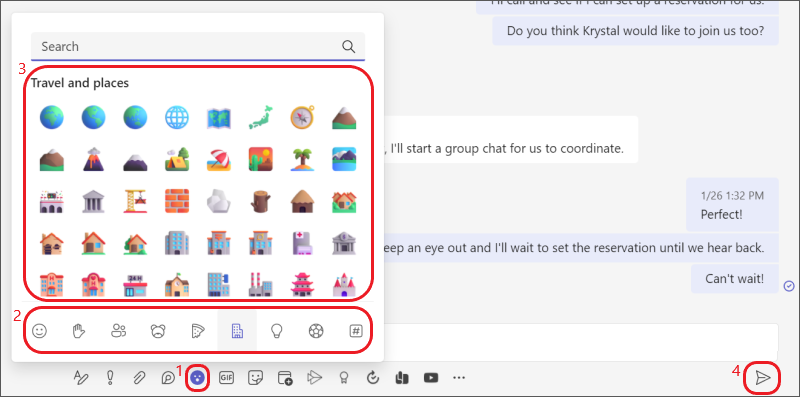
Personalize your emoji
Some emoji—those that include a grey dot in the corner—can be personalized for different skin tones. Just right-click an emoji (one with a grey dot) to open a series of variations for that emoji and then choose the one that you want to send.
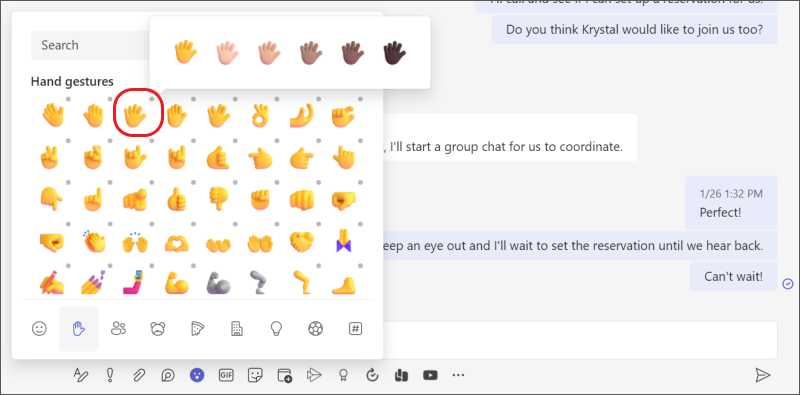
Tips:
-
If you know the name or description of the emoji you’re looking for, use the keyword search box at the top of the gallery. Or, explore by trying different terms.
-
You also can use keyboard shortcuts to choose emoji. To see all emoji keyboard shortcuts, go to View all available emoji.
Send a quick reaction
Say more, more quickly, with quick reactions. Hover over a message and select the one you want. Then watch it appear in the lower-left corner of the message.
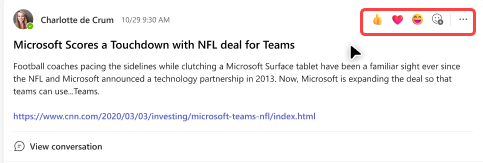
Select More reactions  to choose from a full list of reactions.
to choose from a full list of reactions.
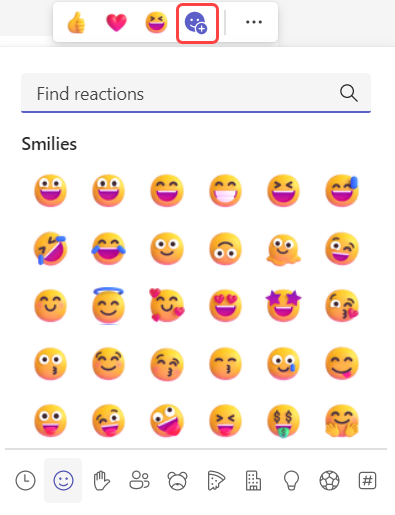
Send a GIF
To send an animated GIF in a chat or channel message, just select GIF  beneath the box. Use the search bar at the top of the window to look for something specific (like "cats playing piano") or browse the collection of popular GIFs. Once you've inserted the GIF you want, select Send
beneath the box. Use the search bar at the top of the window to look for something specific (like "cats playing piano") or browse the collection of popular GIFs. Once you've inserted the GIF you want, select Send  .
.
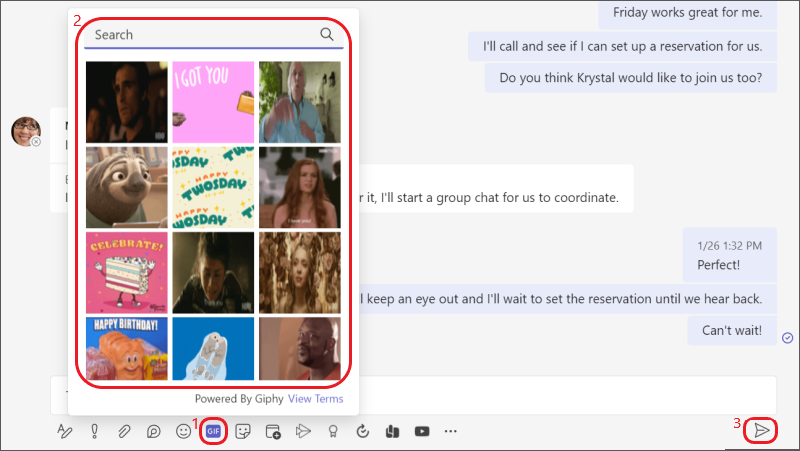
Send a meme or sticker
To send a meme or sticker in a chat or channel, select Sticker beneath the box. If you select Popular, you'll see a collection of the most commonly used memes and stickers. Memes shows you the entire meme library, or you can browse different categories of stickers. After you find the one you want, add captions, select Done, and then Send  .
.
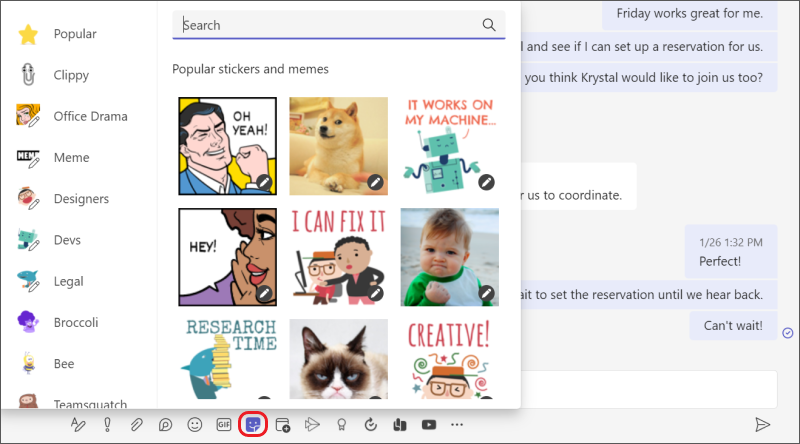
Search for a meme or sticker
To search for a meme or sticker, select Sticker beneath the box. Once you're inside the memes and stickers collection, select Popular. From there, you can enter a search term (like "Grumpy Cat" or "office") into the box at the top to find memes and stickers matching that description.
Customize a meme or sticker
To customize a meme or sticker, select Sticker beneath the box, and pick the meme or sticker you want. Type the text you want into the caption boxes and select Done. Your new (hilarious) caption appears in the meme or sticker, and all you have to do is select Send  .
.
Express your feelings or acknowledge that you've seen what someone's written by adding reactions to your messages.
Just hover over a chat message and choose the reaction you'd like to use.

Select it to use it and then your chosen reaction will show just above the message.

You can share chats or channel conversations to Outlook—without leaving Teams.
Note: You must have Outlook on the Web enabled. If it's turned off, the Share to Outlook option isn't displayed in Teams.
Share a chat from Teams to Outlook
From within Teams, you can share a copy of a chat as an email to Outlook.
-
Select More options  , and then choose the Share to Outlook option.
, and then choose the Share to Outlook option.
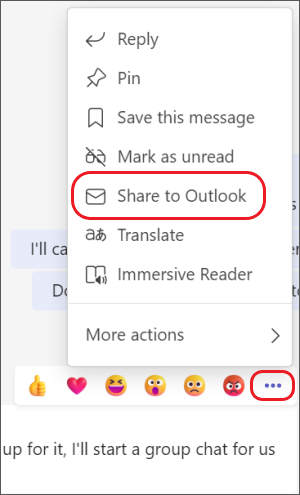
-
Choose your recipient(s). You can also add attachments or customize the message with familiar email options.
-
Select the Send button to share your chat.
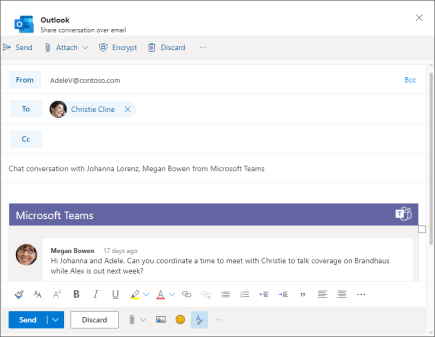
Share a channel conversation from Teams to Outlook
In Teams, you can also share an entire channel conversation as an email to Outlook.
-
In a message, select More options  , and then select the Share to Outlook option.
, and then select the Share to Outlook option.
-
Choose your recipient(s). You can also select from custom options, edit the subject line, and add attachments.
-
Select the Send button to share your channel conversation. This sends the entire conversation history.
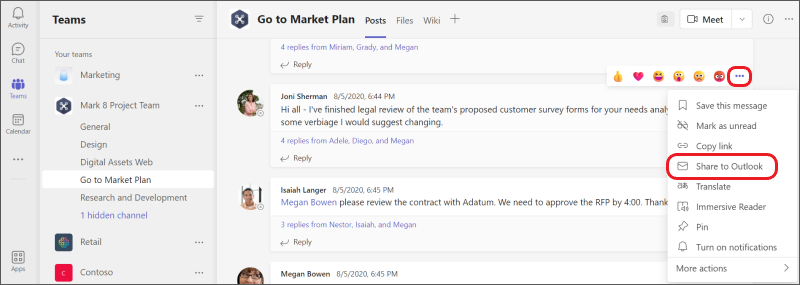
Note: The Share to Outlook feature is currently not supported on mobile.
It’s seamless to collaborate with people outside of your org. In Teams, you can accept or block anyone outside of your org who uses Teams, Teams for personal use, Skype (for consumers), or Skype for Business.
-
When you accept, they’ll be able to send you messages in Teams and Skype. They’ll also be able to view your status.
-
When you block a person, they won’t be able to send you messages in Teams or Skype. They also won’t be able to view your status.
Note: It’s easy to unblock people outside your org.
Accept or block a person in chat
-
Select Chat  to open the chat list.
to open the chat list.
-
Select the chat with the person, and then select Accept or Block.
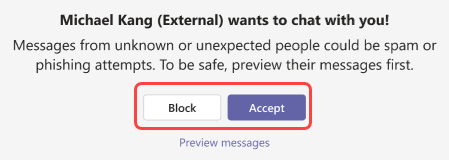
Preview a message before you accept
To avoid spam or phishing attempts, preview the person’s message before you accept.
-
Select Chat  to open the chat list.
to open the chat list.
-
Select the chat with the person, and then select Preview messages.
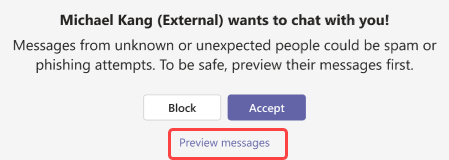
-
Choose Accept or Block.
In Teams, you can block or unblock anyone outside of your org who uses Teams.
-
When you block someone, they won’t be able to communicate with you in Teams or Skype. They also won’t be able to view your status.
-
When you unblock someone, they’ll be able to communicate with you in Teams and Skype. And they’ll be able to view your status.
Note: It’s easy to accept or block people outside your org.
Block a person
There are a couple of ways you can block someone in Teams.
Block a person in the chat list
-
Select Chat  to open the chat list.
to open the chat list.
-
Hover over the person's name, and then select More options  > Block.
> Block.
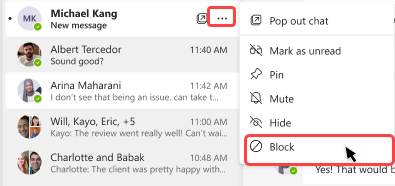
Block a person on their profile card
-
Hover over the person’s profile picture to open their profile card.
-
Select More options  > Block contact.
> Block contact.
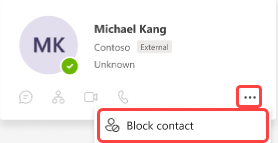
Unblock a person
There are several ways you can unblock someone in Teams.
Unblock a person from the chat
-
Select Chat  to open the chat list.
to open the chat list.
-
Select the chat with the person, and then select Unblock.
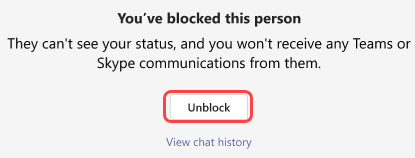
Unblock a person from the chat list
-
Select Chat  to open the chat list.
to open the chat list.
-
Hover over the person's name, and then select More options  > Unblock.
> Unblock.
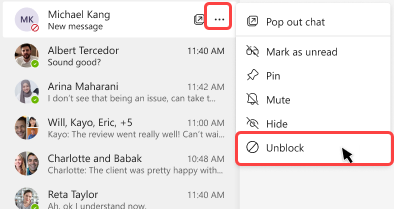
Unblock a person from their profile card
-
Hover over the person’s profile picture to open their profile card.
-
Select More options  > Unblock contact.
> Unblock contact.

Unblock a person from settings
-
Select Settings and more  next to your profile picture.
next to your profile picture.
-
Select Settings.
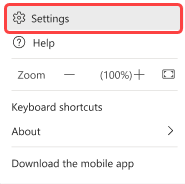
-
Select Privacy. Under Blocked contacts, select Edit blocked contacts.
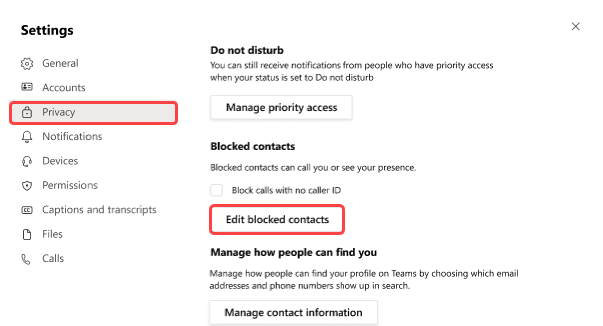
-
Find the person you’d like to unblock, and then select Unblock.

Missed activity emails make it easy to catch up on what you’ve missed when you’ve been away from Teams. You can choose how often you’d like to receive missed activity emails in Outlook. By default, you’ll receive a missed activity email once every hour.
-
Select Settings and more  > Settings
> Settings  > Notifications.
> Notifications.
-
Go to the Email section. Beside Missed activity emails, you can choose how often you’d like to receive a missed activity email.
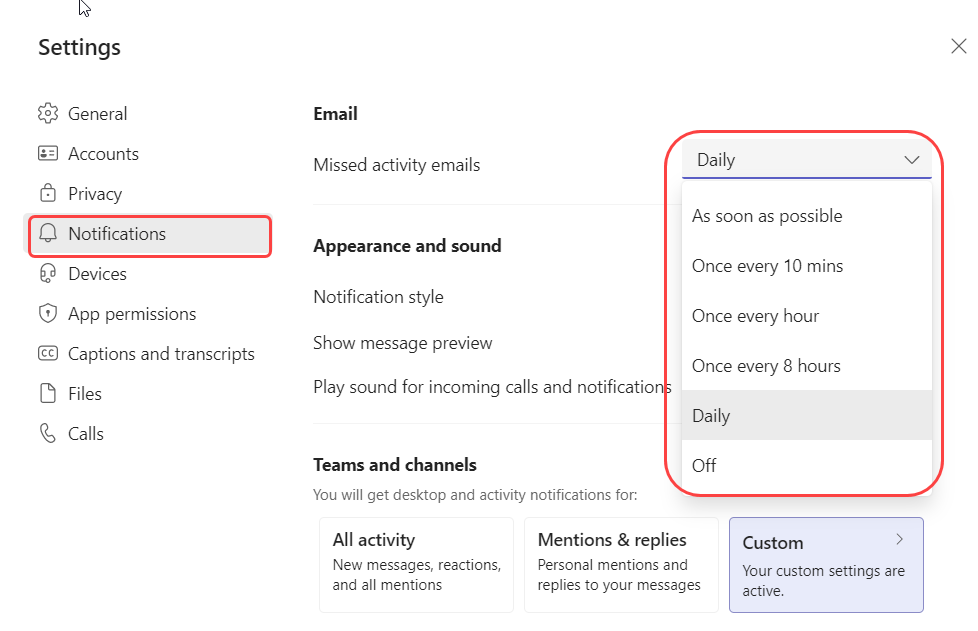
There are three ways to chat with people in Teams:
-
In a channel on the Posts tab (with everyone on the team who follows that channel)
-
In a group chat (with a few people at once, but outside of a channel)
-
In a one-on-one chat (with one other person)
The following are the first things to know:
1. Name your group chat
It's a good idea to name your group chat, so it's clear what the subject of the conversation is.
To start and name a new group chat, select New chat  at the top of your chat list. Select the down arrow at the right side of the To field and then enter a name in the Group name field. You'll see the name at the top of the group chat.
at the top of your chat list. Select the down arrow at the right side of the To field and then enter a name in the Group name field. You'll see the name at the top of the group chat.
To rename a group chat, select Name group chat  at any time.
at any time.

Name your group chat so it's easy to track.
2. Pin frequently used group chats
Pinning is a great way to keep track of a chat even if you only need it temporarily.
To pin a chat, highlight the chat, then select More options  >Pin.
>Pin.
Once you pin a chat, drag it into the order you want. Do this for several chats and you'll have all pinned chats within easy reach.
Unpin the chat when you don't need it front and center anymore. There's a limit of 15 pinned chats.
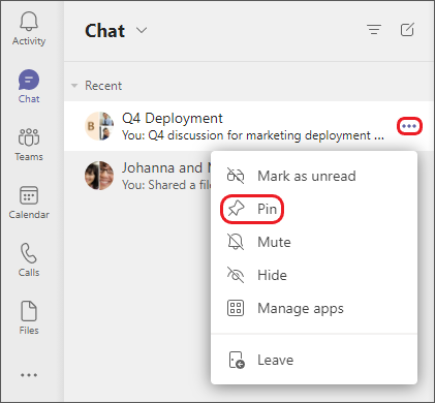
Pin your group chats for easy access.
3. Share files and make calls from your group chat
In a group chat, you can share files and collaborate on them. Then, instantly make calls to the entire group of people in the chat.
There are two ways to share files in chats:
-
Go to the left side of Teams, highlight the file, choose More options  > Copy link, and then paste the link directly into a message.
> Copy link, and then paste the link directly into a message.
-
In the toolbar under your message, select Attach  and upload your document.
and upload your document.
The Files tab in your chat shows all the files you've shared with each other.

The Files tab in your chat shows all the files you've shared with each other.
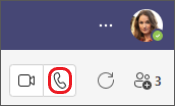
Select Audio call
 to start a call from a group chat.
to start a call from a group chat.
4. Choose how much chat history to include
When you add someone to a group chat, you have a few choices about how much existing chat history they will see.
-
Select View and add participants 
-
Select Add people.
-
Type the names of the people you'd like to add to the chat. Select how much chat history they'll see once they're added.
-
Select Add.
Teams saves the entire chat history going back to the first message. If someone leaves the group, their chat responses remain in your chat history.
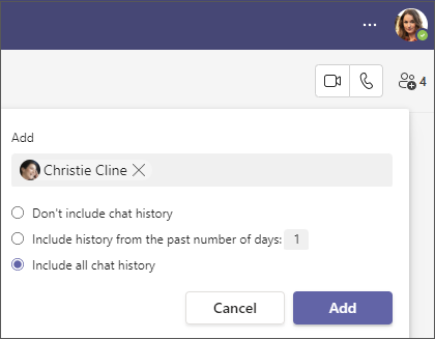
When adding someone to an existing group chat (not a one-on-one), you can include the chat history.
After you join a group chat, you can decide whether you want to remain a member or leave the group chat. You can also remove people from a group chat.
Tip: If you’re leaving a group because you’re receiving too many notifications about new messages, you can instead just turn off notifications or mute the chat from that group.
Leave a group chat
If you decide to leave a group chat in Teams, do the following:
-
Select Chat  to open the chat list.
to open the chat list.
-
Find the name of the group you want to leave.
-
Select More options  > Leave.
> Leave.
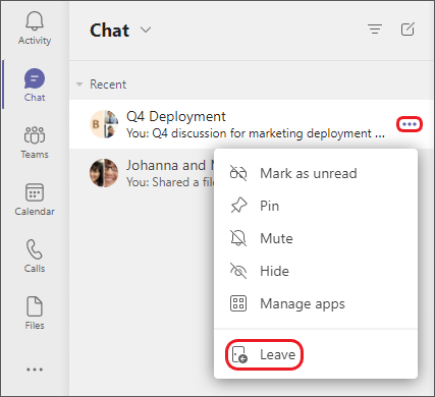
If you change your mind, just ask someone to re-invite you to the group.
Remove people from a group chat
Note: Your admin will need to turn on this setting to allow members to remove each other from a group chat.
To remove people from a group chat in Teams, do the following:
-
Open any group chat of three or more people and go to the top of the chat where it tells you the number of participants.
-
Hover on the number of participants and then hover on the person's name that you want to remove.
-
Select the X and confirm you want to remove the participant from chat.
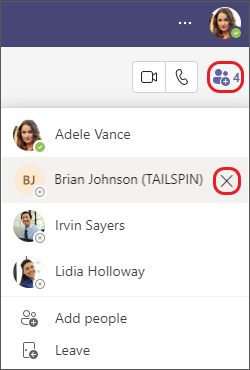
An update in the chat will inform everyone that you've removed the person.
People removed from a chat will be able to view previous chat history, but won't be able to send new messages, react to messages, and won't be able to view new conversations or files shared by the group.
Note: If someone leaves or is removed from a group chat, their messages will remain in the group chat history. However, editing any message in a group chat makes that message invisible to former participants.
Most Teams meetings include a chat where meeting participants can share info without disrupting the flow of the meeting.
Note: This feature may be disabled in your organization. Check with your IT admin for details.
View and send messages
In your meeting controls, a red dot on the Show conversation icon indicates that someone posted a message.

The meeting chat window opens to the right of the main screen.
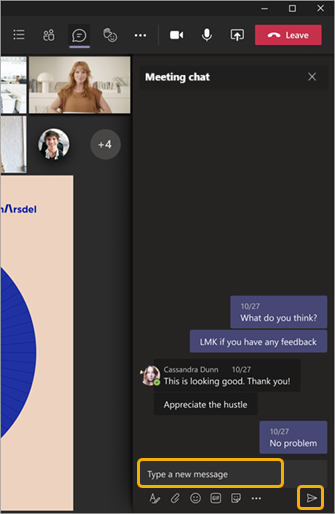
You'll have the same options as other chats in Teams, so you can format your text, send pictures and GIFs, use emojis, attach files, and so on.
If you're part of the Teams public preview program, you'll see chats appear in the main meeting window, without navigating to the Show conversation icon.
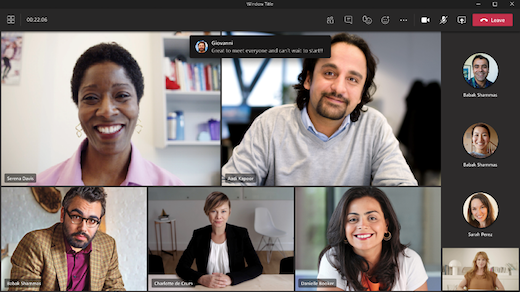
To hide chats from appearing in the main meeting window, select More actions  and choose Don’t show chat bubbles from the menu options.
and choose Don’t show chat bubbles from the menu options.
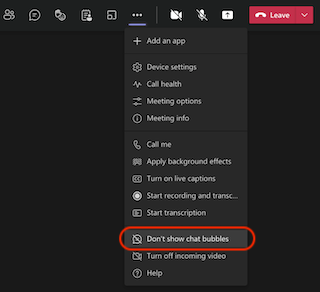
On iOS and Android devices, your two most recent messages will appear for a few seconds as previews at the bottom of the meeting screen.
To snooze chat bubbles, select the snooze icon in the chat bubble.
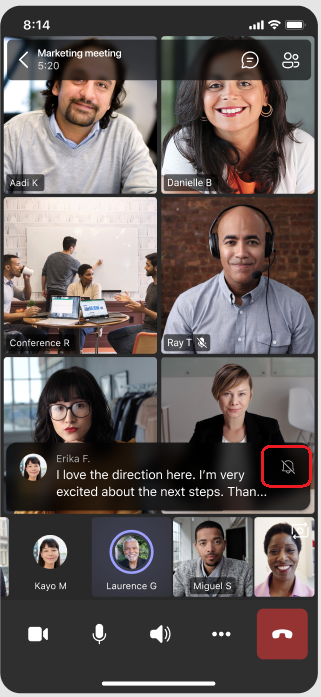
To permanently turn off chat bubbles, select Don't show chat bubbles from the menu at the bottom of the screen.
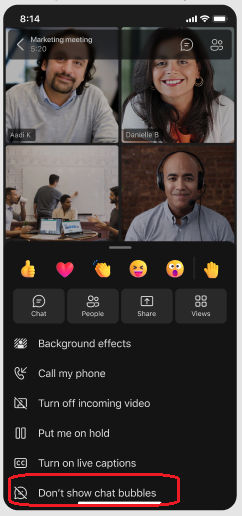
Continue the conversation after the meeting
After the meeting, you can access the chat conversation in several ways:
The following types of meeting attendees with the necessary permissions can continue the conversation they began during the meeting (unless the organizer limited the chat to only during the meeting).
-
All meeting attendees of scheduled single instance meetings will continue to have post-meeting chat access.
-
All meeting attendees of scheduled recurring meetings who are included in the meeting invitation will have post-meeting chat access.
Notes: The following meeting attendees are the exception to the chat accessibility rule as stated above:
-
Attendees who are forwarded an occurrence of the series or those who get nudged into an occurrence of that series will lose post-meeting chat access.
-
All external meeting attendees (i.e., meeting participants who are from another non-federated tenant or anonymous users who are not managed by an organization) will not have chat access in both of the above cases.
-
If someone has been manually removed from the meeting chat or chooses to leave it, they won't have access to the chat going forward.
Start the conversation before the meeting
You can also prep people for an upcoming meeting through a meeting chat (unless the organizer limited the chat).
Note: People who were sent the meeting invitation have access to the meeting chat—before, after, and during the meeting—even if they don’t attend the meeting.
Chat in recurring meetings
For recurring meetings, the chat conversation continues from one meeting to the next. When participants open their chat window, they’ll have access to all the messages that were exchanged in the previous meetings.
Note: If a participant is removed from a recurring meeting series, that participant will lose chat access.
Inviting someone to a single occurrence
People invited to one meeting of a recurring meeting series can participate in the chat with other attendees. They won’t see chat history from previous meetings in the series, but they'll be able to send and view chat messages during the meeting.
If you want to invite someone to join one of your recurring meetings but not the rest, make sure you forward the invite for the single instance, not the entire meeting series, to ensure chat privacy.
Tip: If you've invited an external participant to be a guest speaker and you want to further limit their access to the meeting chat, you can schedule their presentation as the meeting's last session. The meeting organizer or moderator can then monitor the participant list during the meeting, and if the speaker joins outside their allocated time, they can manually remove them.
Note: People you add to a meeting after it starts using the Invite someone box on the participant list have access to the chat from the time they are invited to the time the meeting ends.
Chat in channel meetings
For meetings that are held in a channel, all channel members can view and add to the chat conversation, whether they attend the meeting or not. The conversation will be available on the Posts tab of the channel, beneath the meeting title.
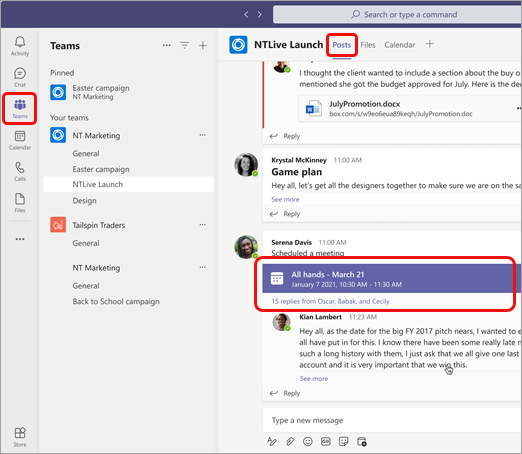
Note: People who are not members of the channel but are invited to a channel meeting won’t have access to the chat.
There are several search and filtering options to help you find messages, people, files, and other info shared in Teams.
Start any search from the search box at the top of Teams. When you type a word or name, Teams will show related results. Either choose one of the suggested items or press Enter to get a full list.
You'll see a search page with a list on the left side of Teams. Choose one of the items to get a full view of the item.
Search your current location with Ctrl+F
Press Ctrl+F (cmd+F on macOS) to search messages within a particular chat or channel in Teams.
-
Choose the area you want to search—for example, a recent chat or the General channel within a team.
-
Press Ctrl+F followed by your search terms, and then press Enter. The search results will be displayed from within that chat or channel conversation.
-
Choose any one of the available results and Teams will scroll up to the location of that particular message.
Search for one-on-one or group chats
Type the person’s name in the search box. You’ll see their name and any group chats listed. Select their name to go to your one-on-one chat with them, or choose a group chat to pick up where you left off.
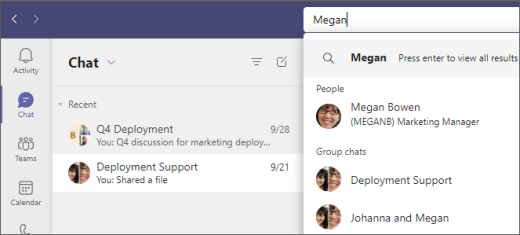
Search for group chats by the chat name (if it has one) or search by the name of the chat participants.
Search for teams and channels
Search for a team or channel by its name in the search box. Select the suggested option in the list to directly navigate to the Team or channel.
Search for messages
Start typing a keyword into the search box and press Enter. This displays a list of results that include the keyword.
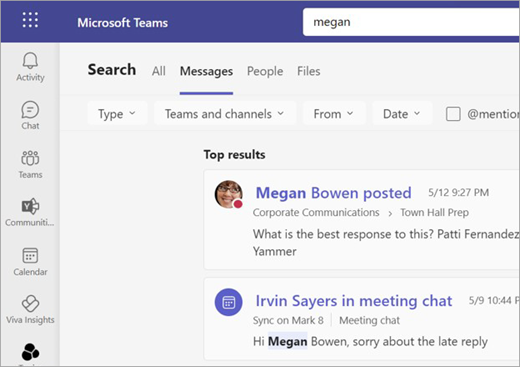
Filter your results
After you’ve entered your search terms into the search box, use the Messages, People, or Files tabs above your results to refine your search. Another tier of filters will appear after you make your initial selection, providing a search option for more granular results.
For example, if you select Messages, you can then filter by who the message is from, where the message is, and more.
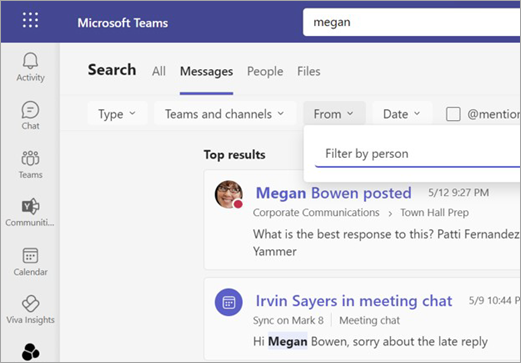
Use search modifiers
For richer search results in messages, use KQL (Keyword Query Language). The following are the modifiers that Teams supports:
Note: Remember that there's no space between the colon and the search terms.
Search tips from the pros
-
Use an asterisk * to get results for any words with a matching prefix. Type the first few letters of a word followed immediately by an asterisk. For example, type "serv*" into the search box, and you'll get results for all words that start with those four letters (server, service, and so on).
-
Use quotation marks to search for an exact match on a word or phrase. Example: “annual budget”.
-
The search box also supports certain spell corrections and nickname matches for people searches.
Filter your activity feed
From the Activity feed, select Filter  to type a keyword. Select More options
to type a keyword. Select More options  to show certain types of messages such as unread messages, @mentions, replies, and likes.
to show certain types of messages such as unread messages, @mentions, replies, and likes.
To only look at your activity, select Feed at the top and then select My activity.
Find your saved messages
To save a message, select More options  > Save this message
> Save this message  .
.
To see a list of your saved messages, select your profile picture at the upper-right of Teams, and then choose Saved. Or, use the shortcut command /saved in the search box.
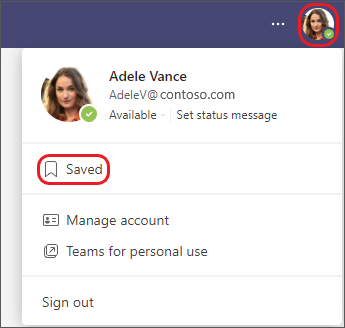
In Teams, it's easy to find and resume a previous conversation by using a keyword or name search.
Find a previous message
All your old messages are saved, and you can search for them (and people, chats, and files) by using the search box at the top of your screen. Choose the conversation that you want to resume.
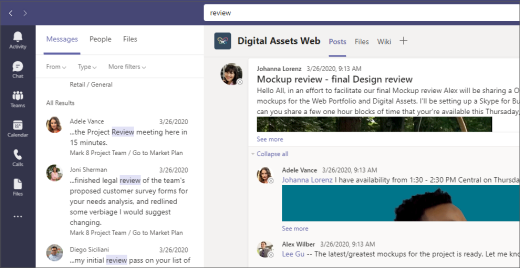
To search for an attachment, look in the Files tab above your search results. Select Filter  to narrow your results.
to narrow your results.
View saved messages
To view your saved messages, select your profile picture from the upper-right corner, and then choose Saved.

Activity feed basics
Select Activity  to view your Activity feed, a summary of everything that's happened in the channels that are in your teams list. Select Filter at the top right corner of the feed to show specific types of messages such as unread messages, @mentions, replies, and likes.
to view your Activity feed, a summary of everything that's happened in the channels that are in your teams list. Select Filter at the top right corner of the feed to show specific types of messages such as unread messages, @mentions, replies, and likes.
For a more specific feed, go to the Feed menu and select My activity. You'll get a list of everything you've been up to lately in Teams.

When a red circle appears next to Activity  , you have a notification—such as an @mention or a reply—in your feed. These notifications remain in your feed for 30 days. After that they expire and no longer show in your feed.
, you have a notification—such as an @mention or a reply—in your feed. These notifications remain in your feed for 30 days. After that they expire and no longer show in your feed.

Notes: Another way to check your notifications is to use the command box at the top of Teams.
Activity feed symbols
We attached unique symbols to different types of notifications in your feed. That way, you can look through your feed and prioritize based on the following:
|

|
@mentions of you specifically.
|
|

|
@team mentions for teams you're on.
|
|

|
@channel mentions in teams you're on.
|
|

|
Replies to your posts.
|
|

|
Posts you liked.
|
|

|
You were added to a team.
|
|

|
You were made a team owner.
|
|

|
Trending posts.
|
|

|
Suggested posts.
|
Haven't found the answer? We can help.
Submit a request
Contact us and we’ll get back to you as soon as possible.